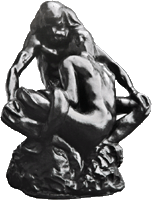 This composition is a combination of the figure of an old man, originally
conceived for 'The Gates of Hell', and a second figure, added by Rodin to
create a new group. The bearded man, sitting slumped forward and leaning
his hands on his widely separated knees, appears twice in 'The Gates',
both times with his back turned towards the viewer. He sits on a tree
stump and signifies therefore, according to Truman Bartlett, an old man
turning into a tree . This composition is a combination of the figure of an old man, originally
conceived for 'The Gates of Hell', and a second figure, added by Rodin to
create a new group. The bearded man, sitting slumped forward and leaning
his hands on his widely separated knees, appears twice in 'The Gates',
both times with his back turned towards the viewer. He sits on a tree
stump and signifies therefore, according to Truman Bartlett, an old man
turning into a tree .
The mythological source for 'Glaucus' is most probably
Ovid's account in the Metamorphoses. Glaucus, from Anthedon in Boeotia,
was a fisherman, who, on eating of the grass on the beach, turned into a
deity of the sea with great powers, wearing a bronze-green beard and
sea-blue arms. He fell in love with Scylla, a nymph known for her unusual
beauty. But Scylla fled in terror for him, believing he was rather a
monster than a god, and no words of Glaucus could calm and convince her.
In his anger, Glaucus turned to Circe, who had caused his transformation,
begging her to transform Scylla into the same kind of creature as he was,
so that she could love him. Circe, however, who loved Glaucus herself,
refused to fulfill his wishes, and out of jealousy instead poisened
Scylla. With an essence of noxious roots,she transformed Scylla into a
monster with dogs springing from her thighs.
In Rodin's sculpture, the beard and the long hair of the
man remind the Glaucus character. Characteristically, Rodin did not
attempt to illustrate the myth with all its details; it is told for
example that Glaucus after his transformation possessed legs forming a
fishes tail, Rodin however presents his Glaucus with two human legs. The
nymph Scylla is crouching in his arms as if seeking refuge or consolation
- another deviation from the original myth. .
The elongated arms of 'Glaucus' seem to create a
cavelike enclosure around her and together with the enlarged back provide
the outline of a pyramidal composition. The faces of the two figures are
reduced to some compositional lines without any detailed modelling.
Rodin executed this composition between 1883, when the
sculpture of the 'Seated Old Man' existed already, and 1891, when a
plaster model of the group 'Glaucus' was sold to the collector Antoni
Roux. The contract of sale identified the plaster as the
"original" sculpture and transferred all rights of reproduction
to Roux, but it is believed that Rodin had already made casts in bronze
and plaster. As a consequence, several "original" 'Glaucus'
plasters later turned up from various public and private collections, each
item was proposed to be the one purchased by Roux. The real Roux plaster
is now kept in the collection of the Musée des Beaux-Arts of
Boulogne-sur-Mer.
|